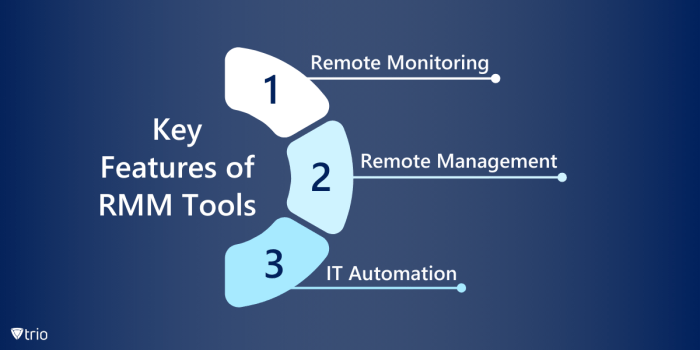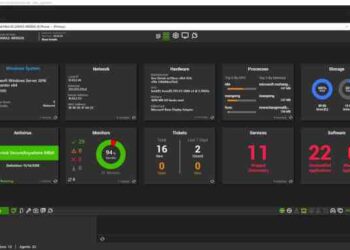Embark on a journey through the essential features of successful RMM tools, exploring the key functionalities that are crucial in modern IT environments. From automation to security measures, this guide delves into the core aspects that make RMM tools effective in managing multiple endpoints.
Essential Features of Successful RMM Tools
Remote monitoring and management (RMM) tools play a crucial role in modern IT environments by allowing organizations to oversee, manage, and maintain their network infrastructure efficiently. These tools provide real-time monitoring, automation capabilities, and security measures to ensure the smooth operation of multiple endpoints within a network.
Real-time Monitoring and Management
RMM tools offer real-time monitoring of endpoints such as servers, workstations, and mobile devices. This feature allows IT administrators to proactively identify issues, track performance metrics, and address potential problems before they escalate. By monitoring key parameters like CPU usage, memory consumption, and network traffic, organizations can ensure optimal performance and prevent downtime.
Automation Capabilities
Automation is a key feature of successful RMM tools, enabling IT teams to streamline repetitive tasks, perform updates, and deploy patches across multiple devices simultaneously. By automating routine processes such as software installations, system updates, and security configurations, organizations can save time, reduce human error, and increase operational efficiency.
Integrated Security Measures
Security is a top priority in IT environments, and RMM tools incorporate various security measures to safeguard network assets. These include features like antivirus protection, firewalls, intrusion detection systems, and data encryption. By implementing robust security measures within RMM tools, organizations can mitigate risks, protect sensitive data, and ensure compliance with industry regulations.
User Interface and Experience
User Interface (UI) and User Experience (UX) play a crucial role in the success of Remote Monitoring and Management (RMM) tools. A user-friendly interface enhances efficiency, simplifies navigation, and improves overall user satisfaction.
Significance of a User-Friendly Interface
A user-friendly interface in RMM tools is essential for increasing user adoption and maximizing productivity. Intuitive design elements, clear layouts, and easy-to-use features make it easier for users to navigate the software, access important information, and perform tasks efficiently.
- Intuitive Navigation: A well-organized interface with logical navigation paths helps users quickly find the information or tools they need.
- Clean Design: Minimalistic design with visually appealing elements reduces clutter and enhances focus on essential functions.
- Consistent Layout: Uniformity in design elements and placement of controls across the interface ensures a seamless user experience.
- Accessibility: Accessibility features such as customizable font sizes, color schemes, and keyboard shortcuts cater to users with diverse needs.
Comparison of UI/UX Designs in RMM Software
Different RMM software may offer varying UI/UX designs, ranging from traditional layouts to modern, sleek interfaces. The impact of these designs on user adoption can be significant, as users tend to prefer software that is visually appealing, easy to navigate, and intuitive to use.
- Traditional Layouts: Some RMM tools may stick to conventional layouts with standard menu structures and control placements. While familiar to experienced users, these designs may feel outdated to newer users.
- Modern Interfaces: RMM software with modern interfaces often feature customizable dashboards, drag-and-drop functionalities, and interactive elements. These designs appeal to a wider audience and enhance user engagement.
Customization Options for Tailoring User Experience
Customization options in RMM tools allow users to tailor the software to their specific requirements, preferences, and workflows. These options enable users to personalize their interface, automate routine tasks, and optimize their workflow for maximum efficiency.
- Dashboard Customization: Users can customize dashboards by adding or removing widgets, rearranging elements, and choosing metrics to display based on their monitoring needs.
- Alert Settings: Customizable alert settings allow users to set thresholds, define notification preferences, and prioritize alerts based on the severity of the issue.
- User Roles and Permissions: Granular control over user roles and permissions ensures that each user has access to relevant features and data, enhancing security and streamlining operations.
Monitoring Capabilities
Monitoring capabilities in top-tier RMM solutions play a crucial role in ensuring the smooth operation of network infrastructure. These tools offer a wide range of features geared towards real-time monitoring and proactive issue resolution.
Real-Time Monitoring Features
- Alerts and Notifications: Top RMM solutions provide real-time alerts for critical events such as system failures, network outages, or security breaches. These alerts enable IT teams to address issues promptly before they escalate.
- Performance Monitoring: Real-time monitoring of system performance metrics like CPU usage, memory consumption, and network bandwidth helps in identifying bottlenecks and optimizing resource utilization.
- Event Log Monitoring: Monitoring event logs in real-time allows for the detection of unusual activities or security breaches, enhancing overall network security.
Scalability of Monitoring Tools
- Auto-Discovery: Scalable monitoring tools offer auto-discovery capabilities, allowing them to automatically detect and monitor new devices or systems added to the network without manual intervention.
- Distributed Monitoring: With the ability to deploy monitoring agents across a distributed network, these tools can scale seamlessly to accommodate a growing infrastructure without compromising performance.
- Customizable Dashboards: Scalable monitoring tools offer customizable dashboards that provide a holistic view of the entire network, making it easier to monitor and manage a large number of devices efficiently.
Reporting and Analytics

Reporting and analytics play a crucial role in optimizing network performance through RMM tools. By providing valuable insights and data-driven information, reporting and analytics help IT professionals make informed decisions, identify trends, and address potential issues proactively.
Key Performance Indicators (KPIs)
- Uptime and Downtime: Monitoring the availability of systems and devices to ensure optimal performance and minimal disruptions.
- Response Time: Measuring how quickly systems respond to user requests or commands.
- Network Traffic: Tracking the volume of data transmitted over the network to manage bandwidth effectively.
- Security Incidents: Monitoring and analyzing security events to detect and prevent cyber threats.
- Resource Utilization: Evaluating the usage of CPU, memory, and storage to optimize resource allocation.
Customization Options for Detailed Reports
RMM software offers customization options for generating detailed reports based on specific metrics tailored to the organization's needs. Users can define parameters, filters, and thresholds to focus on key areas of interest and performance indicators. This flexibility allows IT teams to create reports that align with their goals and objectives, providing actionable insights for improved network management.
Final Review
In conclusion, understanding the importance of user-friendly interfaces, robust monitoring capabilities, and insightful reporting features is key to maximizing the potential of RMM tools in optimizing network performance. Dive deeper into the world of RMM tools to harness their full potential for your IT infrastructure.
Top FAQs
What are the key functionalities that make RMM tools effective in overseeing multiple endpoints?
Key functionalities include automation, real-time monitoring, scalability, and integrated security measures to safeguard network assets.
How important is a user-friendly interface in RMM tools?
A user-friendly interface is crucial for easy adoption and efficient usage of RMM tools by IT professionals.
What role does reporting and analytics play in optimizing network performance with RMM tools?
Reporting and analytics help in tracking key performance indicators (KPIs) and generating detailed reports for network optimization.
![Top 10 RMM Solutions [2024] | NinjaOne](https://ecommerce.mardinata.com/wp-content/uploads/2025/10/Best-RMM-Software-and-Tools-1-75x75.jpg)



![Top 10 RMM Solutions [2024] | NinjaOne](https://ecommerce.mardinata.com/wp-content/uploads/2025/10/Best-RMM-Software-and-Tools-1-120x86.jpg)




